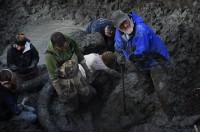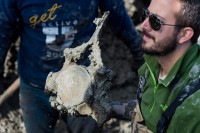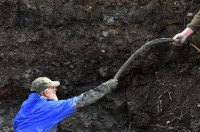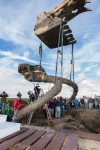 Soybean farmer Jim Bristle was digging in a field in Lima Township, 10 miles southwest of Ann Arbor, Michigan, when he came across what he thought was an old bent fencepost. It was not a fencepost. It was a mammoth bone. When he realized it was a bone very much larger than any cow’s, Bristle contacted the University of Michigan on Tuesday, September 29th. Wednesday evening, Professor Dan Fisher, director of the University of Michigan’s Museum of Paleontology, inspected the bone and the pit where it found. By Thursday morning he had discovered teeth that identified the bones as belonging to a mammoth that roamed the vegetation rich tundra of Michigan between 15,000 and 11,700 years ago.
Soybean farmer Jim Bristle was digging in a field in Lima Township, 10 miles southwest of Ann Arbor, Michigan, when he came across what he thought was an old bent fencepost. It was not a fencepost. It was a mammoth bone. When he realized it was a bone very much larger than any cow’s, Bristle contacted the University of Michigan on Tuesday, September 29th. Wednesday evening, Professor Dan Fisher, director of the University of Michigan’s Museum of Paleontology, inspected the bone and the pit where it found. By Thursday morning he had discovered teeth that identified the bones as belonging to a mammoth that roamed the vegetation rich tundra of Michigan between 15,000 and 11,700 years ago.
 That same day Fisher was able to assemble a team of U-M graduate students with lightning speed, plus volunteers like excavator Jamie Bollinger who brought his own heavy lifting machinery to aid in the endeavor. They dug from 9:00 AM until sunset and were able to recover 20% of the mammoth’s bones: a dramatic skull with two large tusks still attached, the jaw, more teeth, the pelvis, parts of both shoulder blades, one kneecap and multiple ribs and vertebrae. The skull and tusks (which had zip ties all along their length to keep the fragile ivory from breaking off in shards) were raised in one piece and loaded onto a flatbed truck for transportation to the University of Michigan with the rest of the bones.
That same day Fisher was able to assemble a team of U-M graduate students with lightning speed, plus volunteers like excavator Jamie Bollinger who brought his own heavy lifting machinery to aid in the endeavor. They dug from 9:00 AM until sunset and were able to recover 20% of the mammoth’s bones: a dramatic skull with two large tusks still attached, the jaw, more teeth, the pelvis, parts of both shoulder blades, one kneecap and multiple ribs and vertebrae. The skull and tusks (which had zip ties all along their length to keep the fragile ivory from breaking off in shards) were raised in one piece and loaded onto a flatbed truck for transportation to the University of Michigan with the rest of the bones.
 The team also found a small stone flake (a lithic) next to one of the tusks and three basketball-sized boulders in the pit next to the skull. Fisher thinks the mammoth was killed by humans and then stored in a pond that was once on the site, the pre-historic version of refrigeration. The three boulders were used to weight down the carcass. The lithic was broken off a sharp flint knife used to butcher the animal. Fisher has seen the pond preservation method in other prehistoric sites in the region. Only examination of the cleaned bones can confirm or deny this hypothesis. If the mammoth was butchered by people, there will be tell-tale cut marks on the bone.
The team also found a small stone flake (a lithic) next to one of the tusks and three basketball-sized boulders in the pit next to the skull. Fisher thinks the mammoth was killed by humans and then stored in a pond that was once on the site, the pre-historic version of refrigeration. The three boulders were used to weight down the carcass. The lithic was broken off a sharp flint knife used to butcher the animal. Fisher has seen the pond preservation method in other prehistoric sites in the region. Only examination of the cleaned bones can confirm or deny this hypothesis. If the mammoth was butchered by people, there will be tell-tale cut marks on the bone.
 Preliminary examinations indicate the animal was an adult male around 40 to 50 years old that stood about 10 feet high at the shoulders. It appears to be a hybrid of a woolly mammoth and a Columbian mammoth, a very rare find. According to Fisher, skeletal remains of about 300 mastodons and 30 mammoths have been unearthed in Michigan, but only 10 of the mammoths were as complete as this one. He suspects there are more bones to found down there too. Alas, they won’t be coming up anytime soon because Bristle only allowed the one day of excavation before refilling the pit. He was only digging in the first place to make way for the lift station of a new natural gas line and the discovery has not altered his plans.
Preliminary examinations indicate the animal was an adult male around 40 to 50 years old that stood about 10 feet high at the shoulders. It appears to be a hybrid of a woolly mammoth and a Columbian mammoth, a very rare find. According to Fisher, skeletal remains of about 300 mastodons and 30 mammoths have been unearthed in Michigan, but only 10 of the mammoths were as complete as this one. He suspects there are more bones to found down there too. Alas, they won’t be coming up anytime soon because Bristle only allowed the one day of excavation before refilling the pit. He was only digging in the first place to make way for the lift station of a new natural gas line and the discovery has not altered his plans.
Professor Fisher hopes Jim Bristle will donate the bones to the institution.
“It’s really the landowner’s call now,” [Fisher] said, explaining that Bristle now owns the bones. Normally, Fisher explained, the university wouldn’t have put resources into excavating remains without some reassurance that they’d be donated for research. But because these were under such a time crunch, Fisher and his colleagues decided to swoop in. He said on Friday that Bristle has yet to give a verdict on the fate of the bones.
“To really make conclusions about these bones and what they mean, we have to make the evidence available for other scientists to study, too,” Fisher said. “And we can’t do that without long-term access to the material.”
[youtube=https://youtu.be/XbekbGz1cEY&w=430]